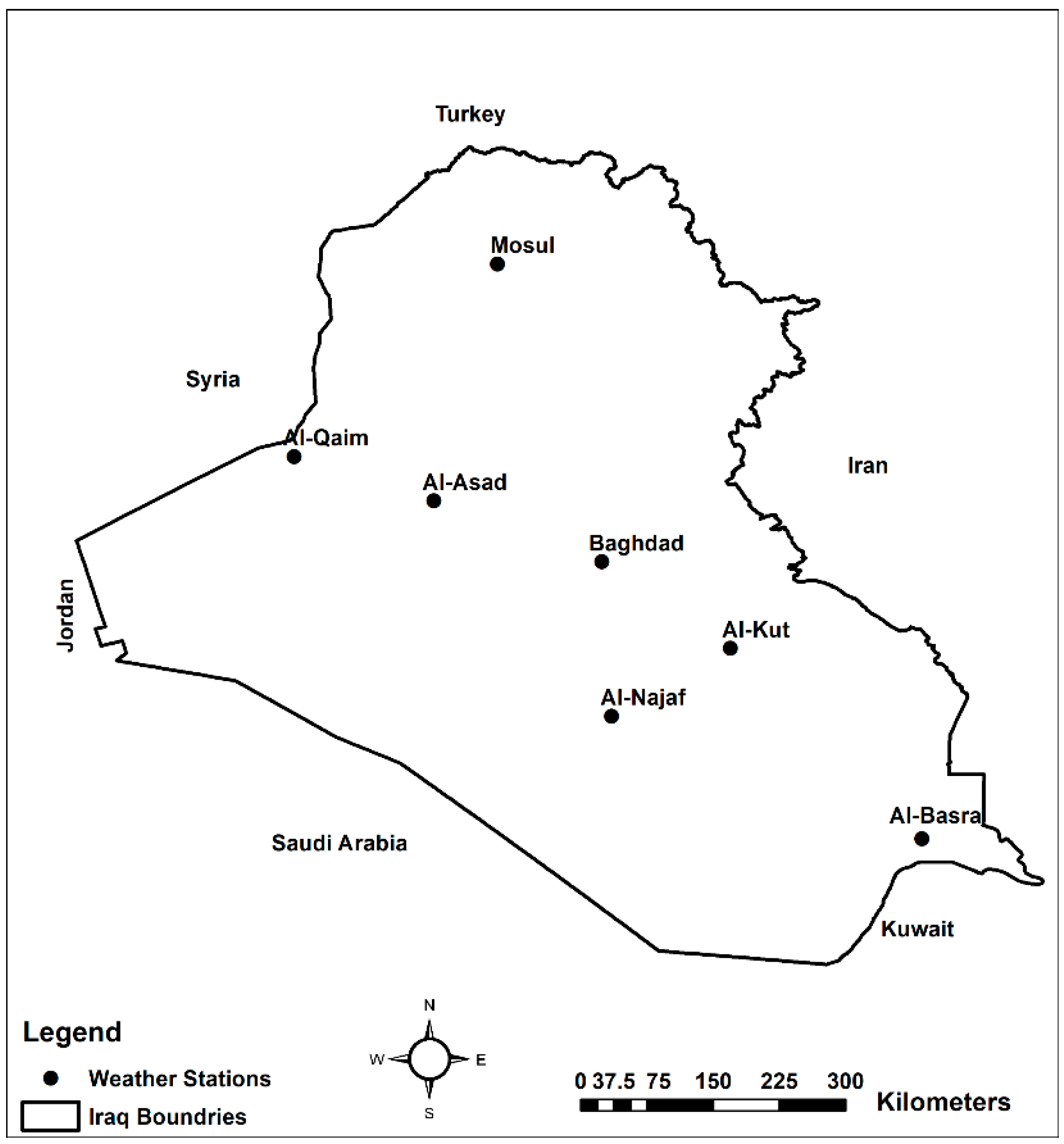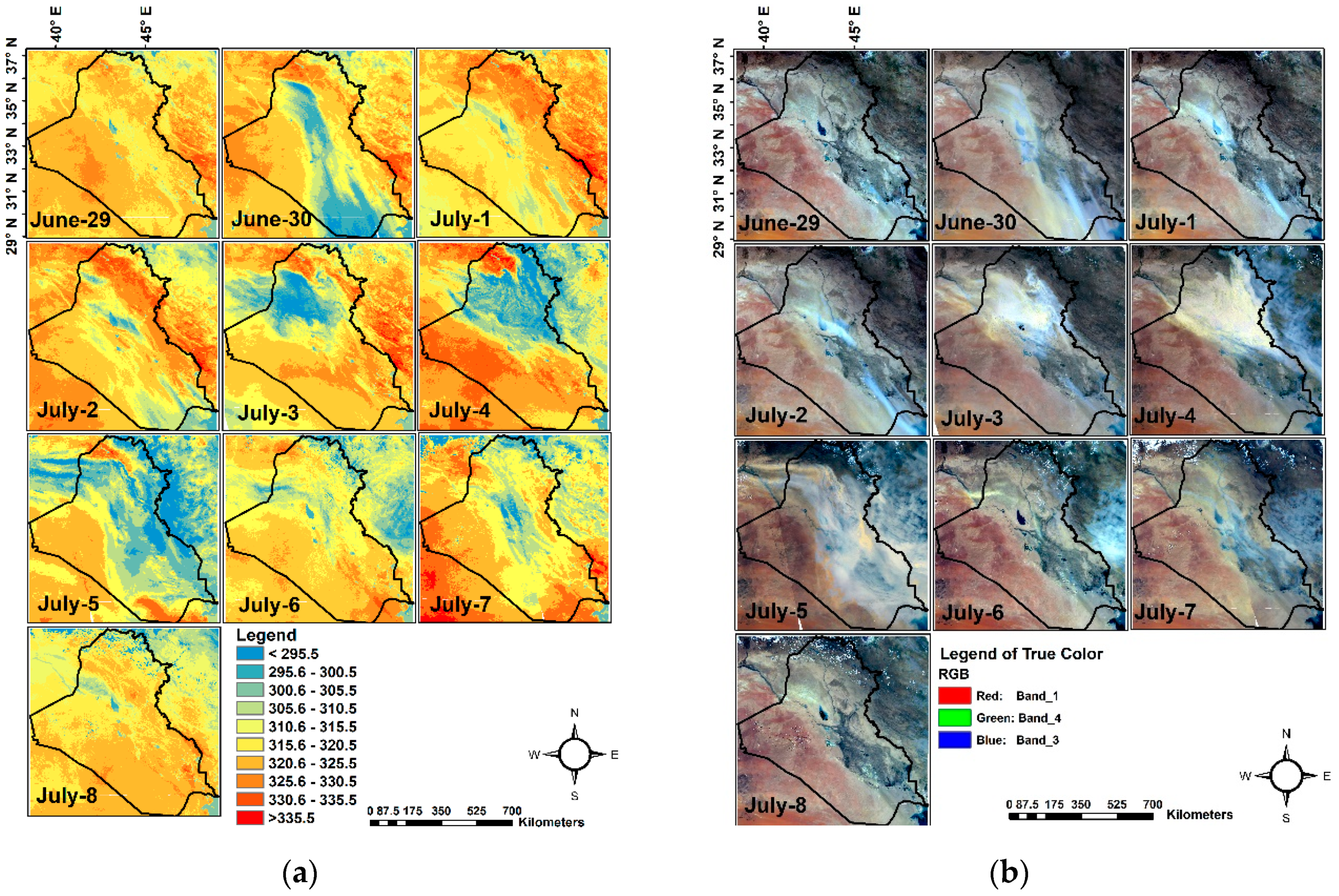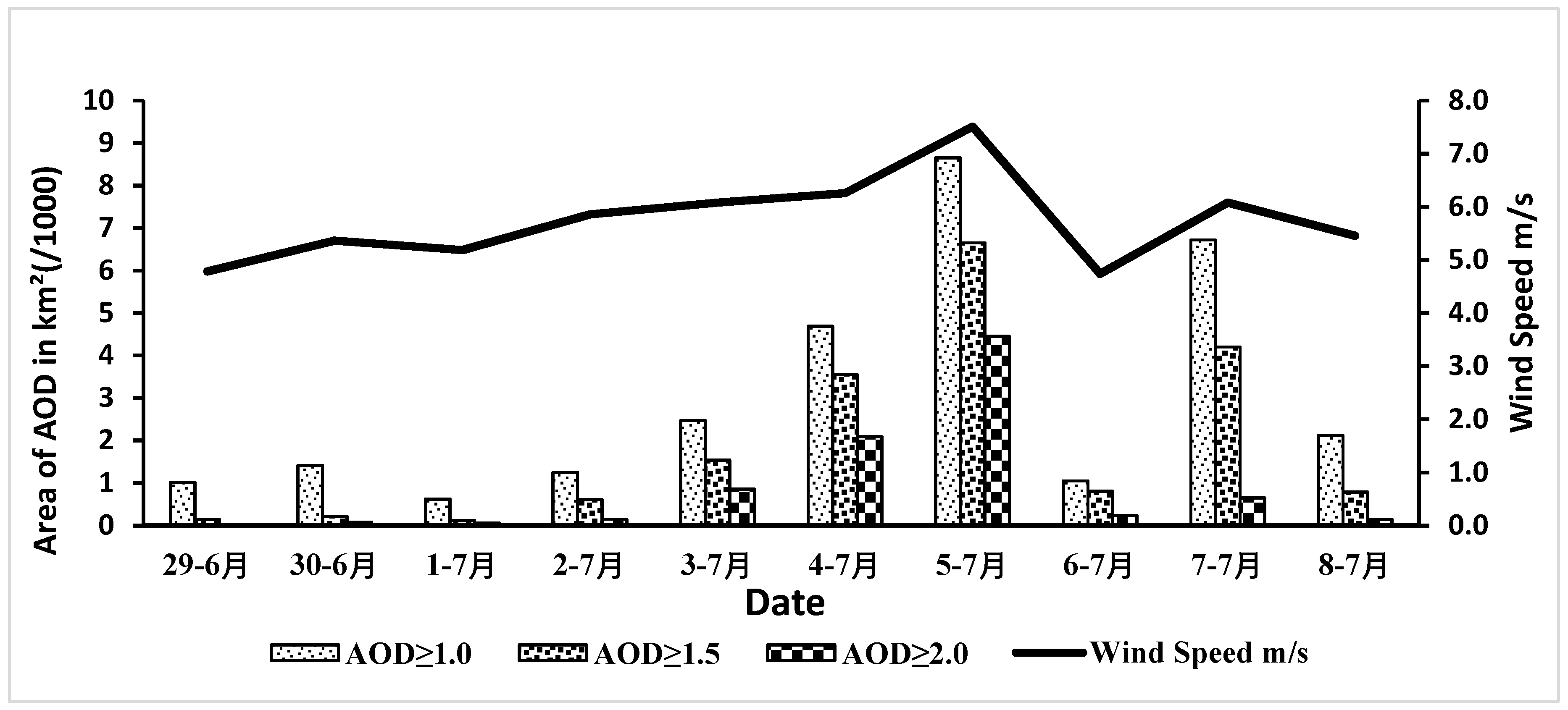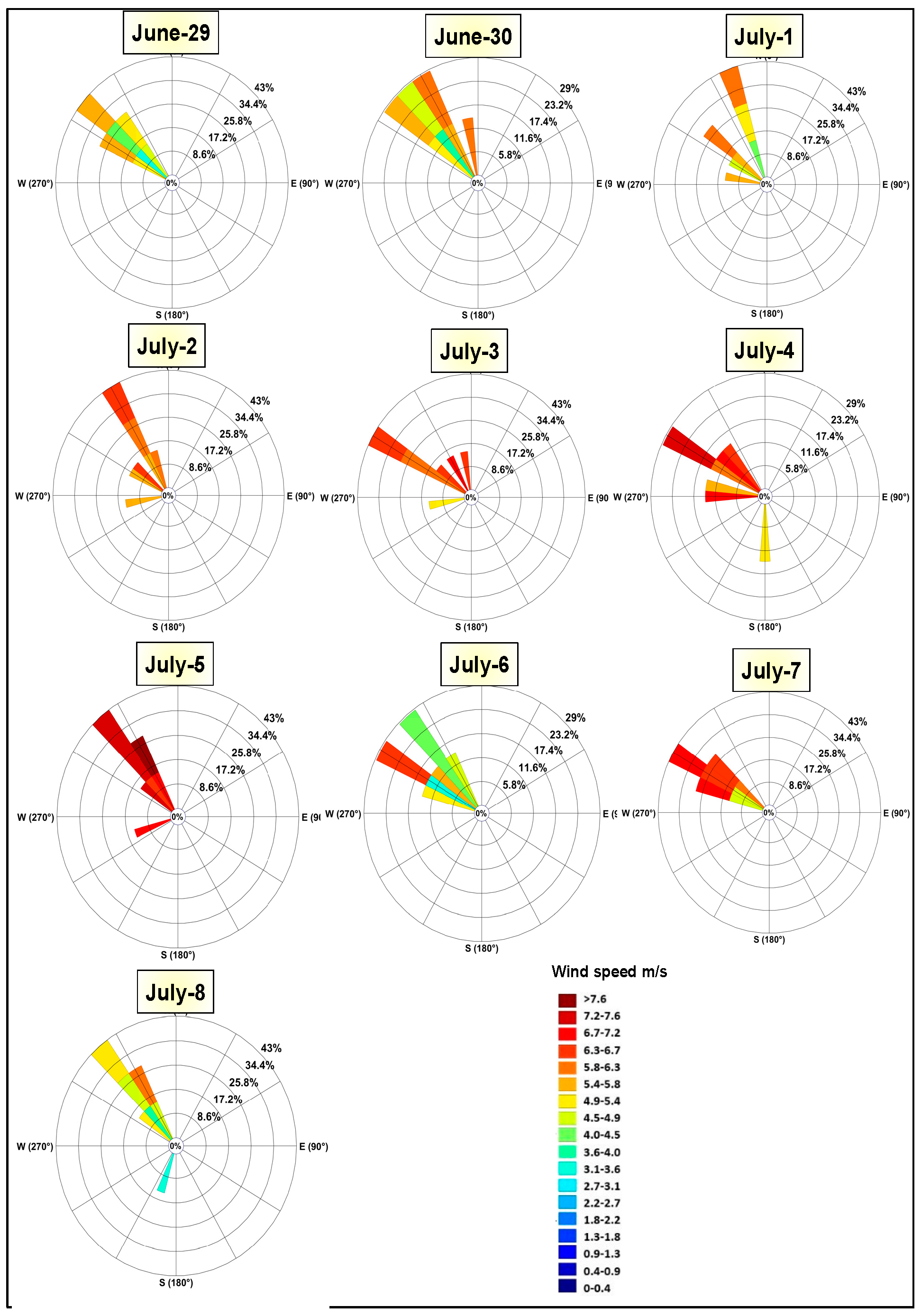Monitoring Dust Storms in Iraq Using Satellite Data
Abstract
1. Introduction
2. Data and Methods
2.1. Data
2.2. Sand and Dust Detection Method
3. Results
3.1. Relationship between NDDI, TB, and True Color
3.2. Aerosol Optical Depth (AOD) and Wind Speed and Direction
4. Discussion and Conclusions
Author Contributions
Funding
Acknowledgments
Conflicts of Interest
References
- Khamooshi, S.; Panahi, F.; Vali, A.; Mousavi, S.H. Dust Storm Monitoring Using HYSPLIT Model and NDDI (Case Study: Southern Cities of Shiraz, Bushehr and Fasa, Iran). ECOPERSIA 2016, 4, 1603–1616. [Google Scholar] [CrossRef]
- Goudie, A.S.; Middleton, N.J. Saharan Dust Storms: Nature and Consequences. Earth Sci. Rev. 2001, 56, 179–204. [Google Scholar] [CrossRef]
- Parolari, A.J.; Li, D.; Bou-Zeid, E.; Katul, G.G.; Assouline, S. Climate, not Conflict, Explains Extreme Middle East dust storm. Environ. Res. Lett. 2016, 11, 114013. [Google Scholar] [CrossRef]
- Someya, Y.; Imasu, R.; Shiomi, K. Dust Aerosol Detection by the Modified CO2 Slicing Method. Sensors 2019, 19, 1615. [Google Scholar] [CrossRef] [PubMed]
- Shepherd, G.; Terradellas, E.; Baklanov, A.; Kang, U.; Sprigg, W.; Nickovic, S.; Boloorani, A.D.; Al-Dousari, A.; Basart, S.; Benedetti, A.; et al. Global Assessment of Sand and Dust Storms; United Nations Environment Programme (UNEP), Publication: Nairobi, Kenya, 1 September 2016; pp. 6–65. [Google Scholar]
- Qu, J.J.; Hao, X.; Kafatos, M.; Wang, L. Asian Dust Storm Monitoring Combining Terra and Aqua MODIS SRB Measurements. IEEE Geosci. Remote Sens. Lett. 2006, 3, 484–486. [Google Scholar] [CrossRef]
- Youlin, Y.; Squires, V.; Qi, L. Global Alarm: Dust and Sandstorms from the World’s Drylands; United Nations Convention to Combat Desertification (UNCCD): Bangkok, Thailand, 2002; pp. 15–25. [Google Scholar]
- Moridnejad, A.; Karimi, N.; Ariya, P.A. A New Inventory for Middle East Dust Source Points. Environ. Monit. Assess. 2015, 187, 582. [Google Scholar] [CrossRef]
- Shao, Y. Physics and Modelling of Wind Erosion, 2nd ed.; Springer Science and Business Media: Heidelberg, Germany, 2008; Volume 37, p. 456. [Google Scholar]
- Chepil, W.S. Dynamics of Wind Erosion: I. Nature of Movement of Soil by Wind. Soil Sci. 1945, 60, 305–320. [Google Scholar] [CrossRef]
- Engelstaedter, S.; Kohfeld, K.E.; Tegen, I.; Harrison, S.P. Controls of Dust Emissions by Vegetation and Topographic Depressions: An Evaluation Using Dust Storm Frequency Data. Geophys. Res. Lett. 2003, 30. [Google Scholar] [CrossRef]
- Bisal, F.; Hsieh, J. Influence of Moisture on Erodibility of Soil by Wind. Soil. Sci. 1966, 102, 143–146. [Google Scholar] [CrossRef]
- Hamidi, M.; Kavianpour, M.R.; Shao, Y. Synoptic Analysis of Dust Storms in the Middle East. Asia Pac. J. Atmos. Sci. 2013, 49, 279–286. [Google Scholar] [CrossRef]
- Sissakian, V.K.; Al-Ansari, N.; Knutsson, S. Sand and Dust Storm Events in Iraq. Nat. Sci. 2013, 5, 1084. [Google Scholar] [CrossRef]
- Chomette, O.; Legrand, M.; Marticorena, B. Determination of the Wind Speed Threshold for the Emission of Desert Dust Using Satellite Remote Sensing in the Thermal Infrared. J. Geophys. Res. 1999, 104, 31207–31215. [Google Scholar] [CrossRef]
- Ravi, S.; D’Odorico, P.; Over, T.M.; Zobeck, T.M. On the Effect of Air Humidity on Soil Susceptibility to Wind Erosion: The Case of Air-Dry Soils. Geophys. Res. Lett. 2004, 31, L09501. [Google Scholar] [CrossRef]
- Natsagdorj, L.; Jugder, D.; Chung, Y.S. Analysis of Dust Storms Observed in Mongolia during 1937–1999. Atmos. Environ. 2003, 37, 1401–1411. [Google Scholar] [CrossRef]
- Wang, X.; Dong, Z.; Zhang, J.; Liu, L. Modern Dust Storms in China: An Overview. J. Arid Environ. 2004, 58, 559–574. [Google Scholar] [CrossRef]
- Ishizuka, M.; Mikami, M.; Yamada, Y.; Zeng, F.; Gao, W. An Observational Study of Soil Moisture Effects on Wind Erosion at A Gobi Site in the Taklimakan Desert. J. Geophys. Res. 2005, 110, D18S03. [Google Scholar] [CrossRef]
- Cowie, S.M.; Knippertz, P.; Marsham, J.H. Are Vegetation-Related Roughness Changes the Cause of the Recent Decrease in Dust Emission from the Sahel. Geophys. Res. Lett. 2013, 40, 1868–1872. [Google Scholar] [CrossRef]
- Hamidi, M.; Kavianpour, M.R.; Shao, Y. Numerical Simulation of Dust Events in the Middle East. Aeolian Res. 2014, 13, 59–70. [Google Scholar] [CrossRef]
- Hamidi, M.; Kavianpour, M.R.; Sao, Y. A Quantitative Evaluation of the 3–8 July 2009 Shamal Dust Storm. Aeolian Res. 2017, 24, 133–143. [Google Scholar] [CrossRef]
- Vermote, E.F.; El Saleous, N.Z.; Justice, C.O. Atmospheric Correction of MODIS Data in the Visible to Middle Infrared: First Results. Remote Sens. Environ. 2002, 83, 97–111. [Google Scholar] [CrossRef]
- Clark, R.N.; Swayze, G.A.; Gallagher, A.J.; King, T.V.; Calvin, W.M. The US Geological Survey Digital Spectral Library: Version 1 (0.2 to 3.0 μm); US Geological Survey: Denver, CO, USA, 1993; Volume 1, pp. 93–592.
- Kim, H.; Choi, M. Impact of Soil Moisture on Dust Outbreaks in East Asia: Using Satellite and Assimilation Data. Geophys. Res. Lett. 2015, 42, 2789–2796. [Google Scholar] [CrossRef]
- Ginoux, P.; Prospero, J.M.; Gill, T.E.; Hsu, N.C.; Zhao, M. Global-Scale Attribution of Anthropogenic and Natural Dust Sources and Their Emission Rates Based on MODIS Deep Blue Aerosol Products. Rev. Geophys. 2012, 50, RG3005. [Google Scholar] [CrossRef]
- Hsu, N.C.; Tsay, S.C.; King, M.D.; Herman, J.R. Aerosol Properties Over Bright-Reflecting Source Regions. IEEE Trans. Geosci. Remote Sens. 2004, 42, 557–569. [Google Scholar] [CrossRef]
- Hassoon, A.F. Determination Trends and Abnormal Seasonal Wind Speed in Iraq. Int. J. Energy Environ. Eng. 2013, 4, 615–628. [Google Scholar]
- Francis, D.B.K.; Flamant, C.; Chaboureau, J.P.; Banks, J.; Cuesta, J.; Brindley, H.; Oolman, L. Dust Emission and Transport Over Iraq Associated with the Summer Shamal Winds. Aeolian Res. 2017, 24, 15–31. [Google Scholar] [CrossRef]
- Prospero, J.M.; Ginoux, P.; Torres, O.; Nicholson, S.E.; Gill, T.E. Environmental Characterization of Global Sources of Atmospheric soil Dust Identified with the Nimbus 7 Total Ozone Mapping Spectrometer (TOMS) Absorbing Aerosol Product. Rev. Geophys. 2002, 40, 2–31. [Google Scholar] [CrossRef]
- Ahn, J.Y. Monitoring Regional Vegetation Changes in Seward Peninsula, Alaska, Using Remote Sensing Technique. Master’s Thesis, University of Calgary, Calgary, AB, Canada, 2 May 2014. [Google Scholar]
- Zolotokrylin, A.N. Dry Winds, Dust Storms and Prevention of Damage to Agricultural Land. In EOLSS; Natural Disaster: Moscow, Russia, 2010; pp. 1–17. [Google Scholar]
- Park, S.S.; Kim, J.H.; Lee, J.; Kim, J.S.; Chang, L.S.; Ou, S. Combined Dust Detection Algorithm by Using MODIS Infrared Channels Over East Asia. Remote Sens. Environ. 2014, 141, 24–39. [Google Scholar] [CrossRef]
- Mohammed, M. Sandstorm Blankets Iraq, Sends Hundreds to Hospital. Available online: https://www.reuters.com/article/idUSL5652707 (accessed on 24 June 2019).
- American Meteorological Society. Glossary of Meteorology. Available online: https://earthobservatory.nasa.gov/NaturalHazards/view.php?id=39206 (accessed on 24 June 2019).
- Al-Ansari, N.; Knutsson, S.; Ali, A. Restoring the Garden of Eden, Iraq. J. Earth Sci. Geotech. Eng. 2012, 2, 53–88. [Google Scholar]
- Richardson, C.J. The Status of Mesopotamian Marsh Restoration in Iraq: A Case Study of Transboundary Water Issues and Internal Water Allocation Problems. In Towards New Solutions in Managing Environmental Crisis; Korhonen-Kurki, K., Fox, M., Eds.; University of Helsinki: Helsinki, Finland, 2010. [Google Scholar]
- Libertino, A.; Sharma, A.; Lakshmi, V.; Claps, P. A Global Assessment of the Timing of Extreme Rainfall from TRMM and GPM for Improving Hydrologic Design. Environ. Res. Lett. 2016, 11, 054003. [Google Scholar] [CrossRef]
- Al-Ansari, N. Management of Water Resources in Iraq: Perspectives and Prognoses. Engineering 2013, 5, 667–684. [Google Scholar] [CrossRef]
- Li, X.; Song, W. Dust Storm Detection Based on MODIS Data. In Proceedings of the International Conference on Geo-Spatial Solutions for Emergency Management and the 50th Anniversary of the Chinese Academy of Surveying and Mapping, Beijing, China, 14–16 September 2009; XXXVIII-7/C4. pp. 169–172. [Google Scholar]
- Butt, M.J.; Mashat, A.S. MODIS Satellite Data Evaluation for Sand and Dust Storm Monitoring in Saudi Arabia. Int. J. Remote Sen. 2018, 39, 8627–8645. [Google Scholar] [CrossRef]
- Xie, Y.; Zhang, W.; Qu, J.J. Detection of Asian Dust Storm Using MODIS Measurements. Remote Sens. 2017, 9, 869. [Google Scholar] [CrossRef]
- Albarakat, R.; Lakshmi, V.; Tucker, C. Using Satellite Remote Sensing to Study the Impact of Climate and Anthropogenic Changes in the Mesopotamian Marshlands, Iraq. Remote Sens. 2018, 10, 1524. [Google Scholar] [CrossRef]
- Hameed, M.; Ahmadalipour, A.; Moradkhani, H. Apprehensive Drought Characteristics Over Iraq: Results of A Multidecadal Spatiotemporal Assessment. Geosciences 2018, 8, 58. [Google Scholar] [CrossRef]
- Albarakat, R.; Lakshmi, V. Comparison of Normalized Difference Vegetation Index Derived from Landsat, MODIS, and AVHRR for the Mesopotamian Marshes Between 2002 and 2018. Remote Sens. 2019, 11, 1245. [Google Scholar] [CrossRef]
- Al-Dousari, A.; Doronzo, D.; Ahmed, M. Types, Indications and Impact Evaluation of Sand and Dust Storms Trajectories in the Arabian Gulf. Sustainability 2017, 9, 1526. [Google Scholar] [CrossRef]
- Doronzo, D.M.; Al-Dousari, A.; Folch, A.; Dagsson-Waldhauserova, P. Preface to the Dust Topical Collection. Arab. J. Geosci. 2016, 9, 468. [Google Scholar] [CrossRef]
- Doronzo, D.M.; Al-Dousari, A. Preface to Dust Events in the Environment. Sustainability 2019, 11, 628. [Google Scholar] [CrossRef]
- Middleton, N.; Kang, U. Sand and Dust Storms: Impact Mitigation. Sustainability 2017, 9, 1053. [Google Scholar] [CrossRef]
- Al-Hemoud, A.; Al-Dousari, A.; Misak, R.; Al-Sudairawi, M.; Naseeb, A.; Al-Dashti, H.; Al-Dousari, N. Economic Impact and Risk Assessment of Sand and Dust Storms (SDS) on the Oil and Gas Industry in Kuwait. Sustainability 2019, 11, 200. [Google Scholar] [CrossRef]
- Kim, S.; Lee, S.; Hwang, K.; An, K. Exploring Sustainable Street Tree Planting Patterns to Be Resistant against Fine Particles (PM2.5). Sustainability 2017, 9, 1709. [Google Scholar] [CrossRef]
- Hamdan, N.M.; Alawadhi, H.; Jisrawi, N.; Shameer, M. Characterization of Fine Particulate Matter in Sharjah, United Arab Emirates Using Complementary Experimental Techniques. Sustainability 2018, 10, 1088. [Google Scholar] [CrossRef]
- Cao, H.; Fu, C.; Zhang, W.; Liu, J. Characterizing Sand and Dust Storms (SDS) Intensity in China Based on Meteorological Data. Sustainability 2018, 10, 2372. [Google Scholar] [CrossRef]





| Date | Dust Area in Km2 | Percentage of Dust Storm Area (%) |
|---|---|---|
| Jun-29 | 52,381.3 | 6 |
| Jun-30 | 141,593.4 | 17 |
| Jul-1 | 51,425.7 | 7 |
| Jul-2 | 57,533.8 | 8 |
| Jul-3 | 234,754.1 | 27 |
| Jul-4 | 251,102.8 | 29 |
| Jul-5 | 540,640.8 | 71 |
| Jul-6 | 209,680.6 | 25 |
| Jul-7 | 206,160.8 | 24 |
| Jul-8 | 128,364.8 | 15 |
© 2019 by the authors. Licensee MDPI, Basel, Switzerland. This article is an open access article distributed under the terms and conditions of the Creative Commons Attribution (CC BY) license (http://creativecommons.org/licenses/by/4.0/).
Share and Cite
Albarakat, R.; Lakshmi, V. Monitoring Dust Storms in Iraq Using Satellite Data. Sensors 2019, 19, 3687. https://doi.org/10.3390/s19173687
Albarakat R, Lakshmi V. Monitoring Dust Storms in Iraq Using Satellite Data. Sensors. 2019; 19(17):3687. https://doi.org/10.3390/s19173687
Chicago/Turabian StyleAlbarakat, Reyadh, and Venkataraman Lakshmi. 2019. "Monitoring Dust Storms in Iraq Using Satellite Data" Sensors 19, no. 17: 3687. https://doi.org/10.3390/s19173687
APA StyleAlbarakat, R., & Lakshmi, V. (2019). Monitoring Dust Storms in Iraq Using Satellite Data. Sensors, 19(17), 3687. https://doi.org/10.3390/s19173687





